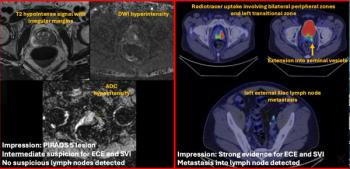
Computer platform upgrade leadsToshiba advances at SNM meeting
Vendor to show dual-head artifact correctionThe nuclear medicine group of Toshiba America Medical Systemsplans to highlight an upgrade in workstation processing speedat the upcoming Society of Nuclear Medicine meeting. Visitorsto Toshiba's SNM
Vendor to show dual-head artifact correction
The nuclear medicine group of Toshiba America Medical Systemsplans to highlight an upgrade in workstation processing speedat the upcoming Society of Nuclear Medicine meeting. Visitorsto Toshiba's SNM booth will also see the Tustin, CA, vendor'swork in simultaneous attenuation correction for its dual-headGCA-7200A gamma camera.
Toshiba has adopted the Sun SparcStation 20 workstation asits on-board image processing computer, according to Steve Sickels,manager of the nuclear medicine unit. The new workstations featureopen architecture and enable Toshiba customers to incorporateoff-the-shelf technology into their computers. Toshiba previouslyused Sun Sparc 1 and Sparc 2 computers with proprietary graphicalinterface boards.
The new workstations are compatible with Toshiba's 16-bit computers,enabling Toshiba customers to add a Sparc 20 computer as an imageprocessing workstation to the older systems, Sickels said.
TransView is Toshiba's term for its work-in-progress attenuationcorrection technique on the dual-head GCA-7200A. Toshiba displayedTransmission CT, a triple-head version of attenuation correction,at last year's SNM meeting in Orlando (SCAN 6/1/94), but willnot highlight that technique at this year's meeting due to thegrowing influence of dual-head systems.
GCA-7200A is an opposable-angle dual-head camera, so Toshibahas fixed the external radiation source on the edge of the topdetector head. Radioactivity from both the injected radiopharmaceuticaland the external source is collected with a slant fan-beam collimator,with a parallel hole collimator acquiring emissions from the radiopharmaceutical.
TransView will improve GCA-7200A's utility in cardiac imagingbut will also have other applications, according to Sickels.
"If you can do cardiac, because of the size of the patient,the location of the heart, and the truncation effect -- if youcan account for all those variables -- then you can do brain andother organs with no problem," Sickels said.
Other advances include:
- S-PET, Toshiba's work-in-progress 511-keV collimator programfor imaging with 18-fluorodeoxyglucose on either the single-heador dual-head cameras;
- OptiCEL, digital detector technology that digitizes signalsafter the signal shaper on the back of each photomultiplier tube;
- GCA-7100A, which will be shown at the SNM conference forthe first time after being launched at last year's RadiologicalSociety of North America meeting (SCAN 11/23/94); and
- a new format display utility that allows physicians to customizehow they format and review nuclear medicine images.
Newsletter
Stay at the forefront of radiology with the Diagnostic Imaging newsletter, delivering the latest news, clinical insights, and imaging advancements for today’s radiologists.




























